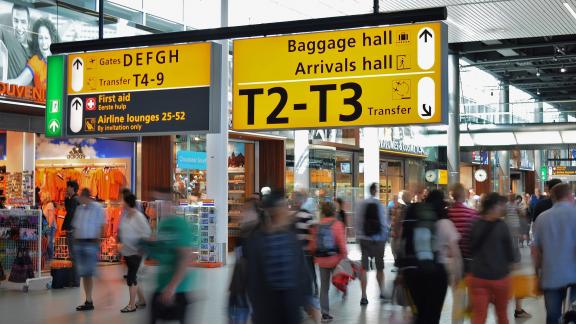
There are six employment check standards that employers must undertake as part of their recruitment processes.
Read the background information about the purpose of the standards, who they apply to and how to meet compliance. We also recommend viewing our frequently asked questions.
We regularly review and update the standards in line with policy and legislation changes. A summary of updates history can be found at the bottom of this page.
This standard outlines the requirements to verify the identity of all prospective employees in the NHS.
Introduction
Checking a candidate's identity is the most fundamental of all the pre-employment requirements, as it forms the basis of all other checks.
The identity check standard includes:
- examples of acceptable forms of documentary evidence in Appendix 1
- guidance on checking documents for authenticity in Appendix 2.
1.1 What is an identity check?
1.1.1 An identity check verifies that an individual is who they say they are. It is the most fundamental of all the employment checks. Undertaking identity checks minimises the risk of employing or engaging an individual who:
- is impersonating another individual
- is avoiding the detection of a criminal offence
- has used illegal means to obtain genuine documents to gain employment.
1.1.2 It should be the first check performed, as all other checks will be rendered invalid if the individual’s identity cannot be proved.
1.1.3 Identity fraud is increasing, and it is important for employers to periodically review local policies and processes to ensure they remain in line with legal requirements and new technologies, as operational standards are strengthened.
1.2 How to verify identity
1.2.1 Employers must check the identity of an individual using a process of:
- requesting original identity documents
- checking the authenticity of the original identity documents
- conducting an in-person meeting
- validating personal details against external reliable sources.
1.2.2 The Good Practice Guide (GPG) 45 for identity proofing and verification issued by Cabinet Office and Government Digital will be a helpful resource, the principles of which are aligned with requirements for identity checking in this document.
Manual identity check - minimum requirements
2.1 Requesting original documents
2.1.1 Individuals must be asked to provide a range of documents that confirm their name, their current address and evidence of residency.
2.1.2 When checking the validity of the documents and that photographs are a true likeness of the person presenting themselves, it is best practice to be in physical possession of the original documents and carry out this examination in person. Other alternative methods include remotely via a live video call, for example, Zoom and FaceTime. Any risks identified when using live video must be assessed and mitigated by employers when choosing to implement this practice. Employers must not rely on the inspection of the documents via a live video link, or by checking a faxed or scanned copy of the document without seeking original documentation as soon as practical e.g. when the individual first takes up the position or are required to undertake induction or other type of training.
2.1.3 Every assurance should be obtained to ensure documents are bona fide and the identity can be attributed to the individual being appointed, including checking that photographs are a true likeness of the person presenting themselves. To verify a person's identity remotely, the following four-step process should be followed:
- Step 1: ask the individual to provide a scanned copy or photo of their original identity documents via email or by using a mobile app.
- Step 2: arrange a video call with the individual and ask them to hold up the original documents to the camera and check them against the digital copies sent by email or mobile app.
- Step 3: record that a check has been done remotely and the date of that check.
- Step 4: seek, verify, and copy original documentation as soon as practical e.g. when the individual first takes up the position or are required to undertake induction or other type of training.
2.1.4 In all cases, employers must take a photocopy or a scanned copy of each of the original documents presented to them and retain these on file in line with current data protection law. All photocopies or scanned copies should be signed, dated, and certified by the person taking the copy (either by hand or digitally). Employers must also conduct an in-person likeness check of the individual before they commence work (see section 2.4 and paragraph 3.1.2).
2.1.5 Employers should refer to the guidance on lawful processing available from the Information Commissioner’s Office (ICO), which includes information on documenting your processes.
2.2 Acceptable documents
2.2.1 Documents that may be obtained and validated as part of an identity check are provided in a recommended list in Appendix 1. These documents are recommended on the basis that they have required the individual to have some form of identity check for them to be issued in the first place and therefore can offer the highest level of assurance when presented in the combinations outlined below.
2.2.2 Individuals will need to provide one of the following combinations:
- two forms of photographic personal identification from List 1, and one document confirming their current residing address from List 2
or
- one form of photographic personal identification from List 1, and two documents confirming their current residing address from List 2.
2.2.3 If an individual genuinely cannot provide any form of photographic personal identification from List 1, they must be asked to provide all the following documentary evidence:
- two documents confirming their current residing address from List 2
- two forms of non-photographic personal identification from List 3
and
- a passport-sized photograph of themselves.
2.2.4 The list of documents provided in Appendix 1 is not exhaustive and is a guide only. Employers may choose to accept and validate alternative documents as part of an identity check but should recognise that not all documents offer the same level of assurance and therefore wherever possible, employers should seek to obtain documents or combinations of documents which can provide the highest level of assurance such as those that have security features or biometrics which are more easily verifiable. The range of documentary evidence should aim to verify the individual’s:
- photograph
- full name (including, forenames, last name, and any other name they legally wish to be known by)
- signature
- date and place of birth
- current residing address
- other biographical and social history information which may be cross-referenced.
All documentary evidence should:
- be issued by a trustworthy and reliable source
- ideally, be difficult to forge
- if dated, be valid and current (see lists in Appendix 1 for further details)
- contain the individual’s full name, photograph, and signature
- have required some form of identity check before being issued to the individual.
2.2.5 Employers should not accept one form of identification to confirm both an individual’s name and address – unless otherwise stipulated in Appendix 1. For example, if an individual provides their driving licence as proof of their name, you will need to seek another form of identification to confirm their address, such as a utility bill.
2.2.6 Where individuals cannot provide any photographic personal identification, you should seek a passport sized photograph which is endorsed on the back with the signature of a person of some standing in their community. Please see the gov.uk website for a list of recommended persons of some standing in the community who can be relied on to counter-sign photographs.
2.3 Checking authenticity of documents
2.3.1 It is not sufficient to accept the documents at face value without undertaking all reasonable effort to verify that they are bona fide.
2.3.2 Producing original documentation to evidence address and social history has become increasingly difficult with the shift to online banking and payment of utility bills. Documents downloaded from the internet offer the lowest level of assurance of identity given that they can be easily obtained and forged, and they do not contain any security features that can be easily checked.
2.3.3 If an individual genuinely cannot provide original documentation, employers may request that they ask their bank or utility provider to endorse and stamp the copy. Alternatively, employers may choose to ask the individual to log in to their online account while in their presence, so that they can verify that the printout is attributed to an actual account in the individual’s name and residing address. If taking the latter approach, any online verification must be purely to ascertain the applicant’s identity, copies of sensitive financial information should remain strictly confidential.
2.3.4 Documents downloaded from the internet should never be accepted in isolation and always be cross-referenced with other forms of original documents presented by the individual.
2.3.5 When considering authenticity of identity documents, employers may find it useful to refer to government guidance on verifying different forms of identification to detect basic forgeries. As well as the public register of authentic travel and identity documents online (PRADO), which shows example images of documents and security features from other countries.
2.3.6 Many employers have invested in electronic ID document scanning devices to support their manual processes to check authenticity. Electronic ID document scanning devices are a valuable aid to detecting fraudulent documents. These devices can check text font, watermarks and other security features that can be detected under ultraviolet light. They cannot detect incidences where individuals have obtained a legitimate document fraudulently. For example, if an individual has fraudulently taken on another identity to obtain further legal documentation in that name. We would therefore recommend that any such devices should be used in conjunction with the manual checks outlined within this document.
2.3.7 Employers must make it clear, in writing, to all applicants that documents presented for identity purposes will be checked for authenticity either manually, through an appropriate body, and/or using an electronic scanning device.
2.4 Conducting in-person meetings
2.4.1 Conducting an in-person meeting is an important and integral part of the recruitment process, providing an opportunity to compare any photographic documentation and other information provided (for example, date of birth) with the likeness of the individual presenting themselves. It is not sufficient to accept documents without undertaking all reasonable checks to validate that they are bona fide, and the individual presenting themselves is the person referred to in those documents.
2.4.2 Where the verification of identity check was conducted remotely earlier in the recruitment process using video calling, such as Zoom, the cross-matching of original documentary evidence must be conducted in-person as soon as practical e.g. when the individual first takes up the position or are required to undertake induction or other type of training. See section 2.1 for further information about the process to verify an individual’s identity remotely.
Who to check and when
Minimum requirements
3.1.1 Employers must ensure the identity of all workers (including volunteers, students, temporary workers, and contractors) has been verified before commencing any type of work or volunteering.
3.1.2 Employers should ask individuals to show some form of photographic identity on their first day, so that this can be cross matched with what was previously provided by the applicant earlier in the recruitment process, and they can be sure that the individual presenting themselves is the person they interviewed.
3.2 Existing employees
3.2.1 Retrospective or periodic checks on existing employees are not usually needed. However, standards and practices used to check and validate identity are improved and strengthened over time. Employers should therefore consider the standards that have historically been applied to existing staff and, where any new standards are significantly different, assess whether repeat checks are necessary.
3.2.2 Any requirement for repeating identity checks must be proportionate to risk and should be conducted when suitable opportunities arise. For example, when an existing member of staff or volunteer changes roles within the same organisation, or when a periodic DBS check is undertaken.
3.2.3 When recording identity checks on the Electronic Staff Record (ESR) or other HR management systems, employers should note the operational standard used at that time, so that they can easily identify when repeat checks may be relevant.
3.2.4 When retaining a record of employment checks, it is highly recommended that the individual’s full legal name (as written on their passport or birth certificate) is accurately recorded alongside all other names by which the individual may be known by. It is the individual’s legal name that is best used as the unique identifier when undertaking additional new or repeat checks to reduce the risk of mismatching records or creating unnecessary duplicates.
3.3 Contractors and temporary workers
3.3.1 For the purpose of these standards, temporary workers are defined as individuals who are not directly employed by an NHS organisation but who have a direct or indirect contractual relationship to provide services to that organisation through an agency, contracting company or other third-party staffing provider.
3.3.2 Where appointing temporary workers, the employing organisation must gain the necessary assurances from the staffing provider that the appropriate clearances, including identity checks have been conducted in compliance with the NHS Employment Check standards.
3.3.3 The employing organisation should make it expressly clear to the staffing provider that they will need to advise any workers they supply, that they will be required to present some form of personal photographic identity on their first day of appointment to verify that they are who they say they are.
Documents presented in different names
4.1.1 There are many legitimate reasons as to why someone may have documents in different names, for example, through marriage, divorce, religious or professional reasons, gender change, or they may prefer to be known by their middle name. They may also be known by a variation of their name, for example, it might say the individual’s name is ‘Samantha’ on their passport, but ‘Sam’ on their bank card.
4.1.2 Individuals may choose to change their name at any time and be known by this name. Any such information must be matched with supporting documentary evidence that recognises the name change. For example, this might include but is not exclusive to:
- a marriage or civil partnership certificate
- a decree absolute/civil partnership dissolution certificate
- a deed poll certificate
- a gender recognition certificate
- a statutory declaration.
4.1.3 If the individual cannot provide sufficient proof of their change of name as described above, employers will need to undertake a risk assessment to determine whether to confirm an unconditional offer of appointment or not. On rare occasions where the necessary assurances cannot be obtained, we would recommend that the risk assessment should be conducted with senior members of the HR recruitment and security teams to ensure a decision not to appoint is reasonable and fair.
Obtaining proof of identity from those furthest from the jobs market
5.1.1 It is recognised that some groups of people who are furthest from the jobs market will find it more difficult to meet the minimum identity checking requirements. For a combination of reasons, this may include homeless people, refugees, asylum seekers, people with learning disabilities and others.
5.1.2 Where candidates are genuinely unable to provide the combination of documents suggested in this document, employers may choose to accept other forms of documentary evidence. Any decision to accept other forms of documentary evidence is down to local discretion. The type of alternative documents you might wish to consider accepting will be dependent on the risks associated with the role and what the individual can genuinely present you with, to give the necessary assurances.
5.2 Prospective employees with no fixed abode
5.2.1 Individuals who have no fixed abode are unable to open bank accounts, receive credit or claim benefits so it is highly unlikely that they will be able to present the range of recommended documents that would normally evidence their identity and residency.
5.2.2 If you operate schemes that support the homeless getting back into the workforce, we recommend that you refer individuals to the charity body, Crisis. This charity can help them to obtain a copy of their birth certificate or apply for a passport so that they can have some form of identity.
5.2.3 Further information on employing homeless people can be found on the Crisis website or by emailing enquiries@crisis.org.uk. There is also a toolkit on the NHS Employers website to help employers to recruit and support employees who have experienced homelessness.
5.3 Refugees
5.3.1 Refugees are permitted to work in the UK under the United Nations Convention relating to the Status of Refugees (the Refugees Convention). Individuals who do not meet the Refugee Convention’s criteria for refugee status may still qualify either for humanitarian protection (granted for a period of five years), or discretionary leave to remain (granted up to a period of three years).
5.3.2 When granted leave to remain in the UK, the Home Office will issue a refugee with an eVisa and a national insurance number, which can be accepted to verify their identity. They must provide the employer with a share code using the view and prove your immigration status: get a share code service (also known as view and prove service). The employer can then use the individual’s share code and their date of birth to verify the individual’s identity details by using the check someone’s immigration status: use their share code service. The individual’s status screen will show their name, date of birth and a photograph to allow for a check to ensure it is of the individual presenting themselves for work. Employers can record the check as a PDF or screen print.
5.3.3 Please note, the Home Office is no longer issuing biometric residence permits (BRPs) but for individuals with a valid immigration status, expired BRPs can be accepted as photo identification up to 18 months beyond their expiry date.
5.3.4 If pre-employment checks are being conducted for refugees who are overseas, employers may choose to accept other forms of documentary evidence such as a passport or a travel document to check their identity. Once granted leave to remain in the UK by the Home Office, employers must verify their identity and check right to work in the UK using the Home Office online checking services.
5.3.5 For further information about NHS pre-employment checks for refugees and other forcibly displaced people see our FAQ page.
5.4 Young people who are in or have recently left full-time education (16–19 year-olds)
5.4.1 Every care must be taken to ensure that recruitment processes do not create any unintended barriers which may discourage or restrict the employment of young people.
5.4.2 It is recognised that it may be problematic for certain young people to present the suggested documents, especially if they have just left full-time education and are seeking employment for the first time. Where individuals are genuinely unable to do so, employers should, as a minimum, seek the following combination of documents:
One form of personal photographic identity:
- An identity card carrying the PASS accreditation logo (UK, including Channel Islands and Isle of Man), such as a UK Citizen ID card or a Connexions card (must be valid and in-date).
- A passport-sized photograph that is counter-signed by a person of some standing in the individual’s community.
and
Two forms of documentary evidence from the list below:
- a grant or student loan agreement from a local education authority (UK)
- a qualification certificate
- a full birth certificate (UK and Channel Islands) issued after the date of birth by the General Register Office or other relevant authority, for example registrars
- a full birth certificate issued after the date of birth by UK authorities overseas, such as embassies, high commissions and HM forces
- National Insurance card, or letter from the HM Revenues and Customs, Job Centre or Employment Services evidencing the issue of a National Insurance number
- a letter from their head teacher, tutor or college principal (UK), verifying their name and other relevant information, for example, address and date of birth
- a document from a local/central government authority or local authority giving entitlement such as Employment Services, Job Centre, Social Security Services (UK and Channel Islands).*
*All documents must be dated within the last six months, unless there is good reason for it not to be, for example, where there is clear evidence that the individual was not living in the UK for six months or more.
** All documents must be dated within the last 12 months. If not denoted, the document can be more than 12 months old.
Doubts on the authenticity of information
6.1.1 Countries do occasionally change their passports, so employers will need to handle any discrepancies sensitively. If there is any doubt as to the authenticity of the passport presented by the individual, employers should contact the Home Office to make sure the passport for that country hasn't changed.
6.1.2 Further guidance can be found on the UK visas and immigration section of the gov.uk website. Alternatively, employers can call the Employers and Education Providers helpline: 0300 123 4699.
6.1.3 Employers can also use their local counter-fraud service to do this on their behalf.
6.1.4 Where checks return information that contradicts the details provided by the individual and raises concerns, employers should:
- proceed in a sensitive manner, there is often a reasonable explanation for apparent inconsistencies
- attempt to address any concerns directly with the individual. Employers may wish to call them back for a second interview so that they have the opportunity to follow up with the relevant sources.
6.1.5 In exceptional circumstances, where checks reveal substantial misdirection, employers may feel it appropriate to report these concerns to the NHS Counter Fraud Authority or the local police. Employers can also call the 24-hour fraud and corruption reporting line on 0800 028 40 60.
Appendix 1: Recommended forms of documentary evidence for proof of identity
Lists 1, 2 and 3 below outline a range of documents which, when presented in the specified combinations, can be more accurately relied on to provide the necessary proof of an individual’s identity. This is because the individual will have gone through some form of identity check for the document(s) to be issued to them in the first place.
The lists of documents are not exhaustive and should be used as a guide only.
Appendix 2: Checking documents for authenticity
Further information
See a list of recommended persons of some standing in the community who can be asked to counter-sign passport-sized photographs where individuals are genuinely unable to provide other forms of photographic personal ID.



